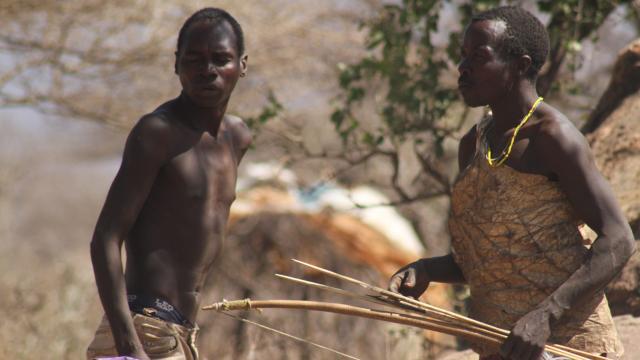The Hazda is a small group of hunter-gatherers living in the central Rift Valley of Tanzania, one of the few remaining groups of people left in the world who still collect the majority of their diet through foraged foods. Modernity has still managed to touch their lives, of course, but far less than it has for those of us in the post-industrialised West. For this reason, scientists have long been interested in studying their biology, in hopes of gleaning something about humanity’s evolutionary path.
Image: Wikimedia
A new study out of Stanford looks to the Hazda people to understand specifically the evolution of our diet and the bacteria in our gut. The study, published Thursday in Science, confirmed the results of several smaller studies in finding that the gut bacteria in the Hazda people was significantly different and more diverse than those of us in the industrialised world. They also found something new: That the makeup of that gut bacteria changes significantly from season-to-season.
“All of the traditional populations have a certain set of gut microbes. We can look at them to infer the microbiome we should have evolved with,” Justin Sonnenburg, a Stanford microbiologist and the study’s lead author, told Gizmodo. “In the industrialised world, we now may have lost many of those bacteria.”
The microbiome has garnered much attention from both scientists and popular culture because we are beginning to understand that the trillions of microorganisms that inhabit our body — particularly those in our gut — play an important role in our overall health. There is compelling evidence to suggest that those gut bacteria can affect disease, mental health and even athletic ability. In one incredible study earlier this year, researchers traced the origin of a head-scratching brain disorder to a particular type of bacteria living in the gut. Another new study out Thursday found a link between anxiety and all that bacteria in our gut.
“The most important thing for people to understand is that we are composite organisms. We’re not just human cells,” said Sonnenburg. “It leads to this question of what microbes are the best for our health. We don’t have a good answer yet.”
Which leads to the Hazda people. Over the past 100 years, some aspects of modernity have begun to affect them — their population has become a tourist attraction, and groups such as missionaries often donate money and food. But before that, their way of life was virtually unchanged for thousands of years, and they still live similarly to how our distant ancestors would. This could offer some clues into how we once ate, and perhaps even how we should.
To better understand patterns between diet and the microbiome, researchers collected 350 faecal samples from 188 Hadza people across different seasons. As hunter-gatherers, their diet varies drastically by season. In the wet season, they eat a lot of foraged berries and honey. The dry season is optimal for the hunt.
They found that 70 per cent of gut bacteria disappeared between the end of the dry season and beginning of the wet season, only to reappear later. This suggests not only that what we eat and the microorganisms that live inside us are intimately linked, but that it is possible to change the makeup of our gut bacteria very rapidly based on diet.
They also compared the Hazda people’s microbiome to that of 18 other populations of hunter-gatherers in 16 countries around the world. While the Hazda people’s microbiome varies significantly from people in the industrial world, they found striking similarities to other traditional populations. Two prevalent bacterial families within the Hadza and other traditional groups were either rare or completely undetected in people following non-traditional diets. The Hadza also had more enzymes to process plant carbohydrates than people eating a Western diet.
“One thing I feel pretty confident in is that our microbiome has definitely changed, and it looks like a deterioration,” said Sonnenburg. “It really looks like an ecosystem in disrepair.”
Alyssa Crittenden, a nutritional anthropologist who has studied the Hazda people for 13 years, said that the work is important in confirming many previous studies about traditional microbiomes, and in discovering the seasonality of gut bacteria.
But she said it also poses more questions than answers — further study is needed to know what sorts of dietary choices and behaviours caused those seasonal changes.
Crittenden also warned against adopting the hunter-gatherer diet for yourself. While dozens of startups have launched claiming to be able to sequence your microbiome and tell you what sort of bacterial supplements you might need, this science is still in its early days.
“We need to be very careful about adopting any diet that portends to be mimicking our evolutionary past,” she said. “The microbiome is influenced by our whole world, not just what we eat.” It’s not just what the Hazda are eating, but where and how they are eating it, too.
Crittenden noted that it’s an important time to study the Hazda people, since their way of life is at the moment changing rapidly.
“Last year alone, 14 tons of corn was dropped into Hazda camps by missionaries,” she said. The Hazda gut is right now undergoing industrialisation.”
Sonnenburg, who co-authored a book called The Good Gut, a wellness book about the microbiome, said the only sure-fire takeaway from studying the Hazda people is that a high-fibre diet is probably ideal. (Crittenden, who has also studied the Hazda microbiome, agreed.)
“That’s about the extent of what we can tell people,” he said. “All the rest of what you might hear is a bunch of hooey.”
As the science progresses, though, he said insights from traditional groups like the Hazda people may help lead to discoveries about how to fight disease and mental health problems like depression.
“It’s going to be very powerful,” he said.
[Science]
